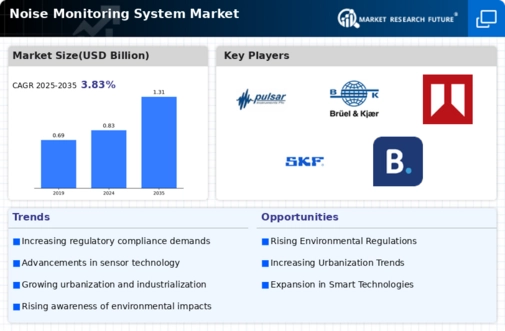-
MARKET INTRODUCTION
-
INTRODUCTION
-
SCOPE OF STUDY
- RESEARCH OBJECTIVE
- ASSUMPTIONS
- LIMITATIONS
-
MARKET STRUCTURE:
- GLOBAL NOISE MONITORING SYSTEM MARKET: BY MONITORING SYSTEM
- GLOBAL NOISE MONITORING SYSTEM MARKET: BY MONITORING METHOD
- GLOBAL NOISE MONITORING SYSTEM MARKET: BY COMPONENT
- GLOBAL NOISE MONITORING SYSTEM MARKET: BY END USER
- GLOBAL NOISE MONITORING SYSTEM MARKET: BY REGION
-
RESEARCH METHODOLOGY
-
RESEARCH MONITORING METHOD
-
PRIMARY RESEARCH
-
SECONDARY RESEARCH
-
FORECAST MODEL
-
MARKET DYNAMICS
-
INTRODUCTION
-
MARKETDRIVERS
-
MARKETCHALLENGES
-
MARKETOPPORTUNITIES
-
EXECUTIVE SUMMARY
-
MARKET FACTOR ANALYSIS
-
PORTER’S FIVE FORCES ANALYSIS
-
SUPPLY CHAIN ANALYSIS
-
NOISE MONITORING SYSTEM MARKET
-
INTRODUCTION
-
MARKET STATISTICS
- BY MONITORING SYSTEM
- BY MONITORING METHOD
- BY COMPONENT
- BY APPLICATION
- BY REGION
-
COMPANY PROFILES
-
EXTECH INSTRUMENTS (U.S.)
-
B&K PRECISION CORPORATION (U.S.)
-
PULSAR INSTRUMENTS (U.K)
-
3M COMPANY (U.S.)
-
RION CO. LTD. (JAPAN)
-
CIRRUS RESEARCH PLC (U.K)
-
CASTLE GROUP LTD. (U.K)
-
CASELLA INC. (U.S.)
-
KIMO INSTRUMENT (JAPANS)
-
SKF GROUP (SWEDEN)
-
BRUEL & KJAER (DENMARK)
-
B&K PRECISION CORPORATION (U.S.)
-
LIST OF TABLES
-
NOISE MONITORING SYSTEM MARKET, BY MONITORING SYSTEM
-
NOISE MONITORING SYSTEM MARKET, BY MONITORING METHOD
-
NOISE MONITORING SYSTEM MARKET, BY COMPONENT
-
NOISE MONITORING SYSTEM MARKET, BY APPLICATION
-
NOISE MONITORING SYSTEM MARKET, BY REGIONS
-
NORTH AMERICA NOISE MONITORING SYSTEM MARKET, BY MONITORING SYSTEM
-
NORTH AMERICA NOISE MONITORING SYSTEM MARKET, BY MONITORING METHOD
-
NORTH AMERICA NOISE MONITORING SYSTEM MARKET, BY COMPONENT
-
NORTH AMERICA NOISE MONITORING SYSTEM MARKET, BY END USER
-
NORTH AMERICA NOISE MONITORING SYSTEM MARKET, BY REGION
-
U.S. NOISE MONITORING SYSTEM MARKET, BY MONITORING SYSTEM
-
U.S. NOISE MONITORING SYSTEM MARKET, BY MONITORING METHOD
-
U.S. NOISE MONITORING SYSTEM MARKET, BY COMPONENT
-
U.S. NOISE MONITORING SYSTEM MARKET, BY APPLICATION
-
U.S. NOISE MONITORING SYSTEM MARKET, BY REGION
-
EUROPE NOISE MONITORING SYSTEM MARKET, BY MONITORING SYSTEM
-
EUROPE NOISE MONITORING SYSTEM MARKET, BY MONITORING METHOD
-
EUROPE NOISE MONITORING SYSTEM MARKET, BY COMPONENT
-
EUROPE NOISE MONITORING SYSTEM MARKET, BY APPLICATION
-
EUROPE NOISE MONITORING SYSTEM MARKET, BY REGION
-
U.K. NOISE MONITORING SYSTEM MARKET, BY MONITORING SYSTEM
-
U.K. NOISE MONITORING SYSTEM MARKET, BY MONITORING METHOD
-
U.K. NOISE MONITORING SYSTEM MARKET, BY COMPONENT
-
U.K. NOISE MONITORING SYSTEM MARKET, BY SERVICES
-
U.K. NOISE MONITORING SYSTEM MARKET, BY APPLICATION
-
U.K. NOISE MONITORING SYSTEM MARKET, BY REGION
-
ASIA-PACIFIC NOISE MONITORING SYSTEM MARKET, BY MONITORING SYSTEM
-
ASIA-PACIFIC NOISE MONITORING SYSTEM MARKET, BY MONITORING METHOD
-
ASIA-PACIFIC NOISE MONITORING SYSTEM MARKET, BY COMPONENT
-
ASIA-PACIFIC NOISE MONITORING SYSTEM MARKET, BY APPLICATION
-
ASIA-PACIFIC NOISE MONITORING SYSTEM MARKET, BY REGION
-
REST OF WORLD NOISE MONITORING SYSTEM MARKET, BY MONITORING SYSTEM
-
REST OF WORLD NOISE MONITORING SYSTEM MARKET, BY MONITORING METHOD
-
REST OF WORLD NOISE MONITORING SYSTEM MARKET, BY COMPONENT
-
REST OF WORLD NOISE MONITORING SYSTEM MARKET, BY APPLICATION
-
REST OF WORLD NOISE MONITORING SYSTEM MARKET, BY REGION
-
LIST OF FIGURES
-
RESEARCH METHODOLOGY
-
NOISE MONITORING SYSTEM MARKET: BY MONITORING SYSTEM (%)
-
NOISE MONITORING SYSTEM MARKET: BY MONITORING METHOD (%)
-
NOISE MONITORING SYSTEM MARKET: BY COMPONENT (%)
-
NOISE MONITORING SYSTEM MARKET: BY APPLICATION (%)
-
NOISE MONITORING SYSTEM MARKET: BY REGION (%)
-
NORTH AMERICA NOISE MONITORING SYSTEM MARKET, BY MONITORING SYSTEM (%)
-
NORTH AMERICA NOISE MONITORING SYSTEM MARKET, BY MONITORING METHOD (%)
-
NORTH AMERICA NOISE MONITORING SYSTEM MARKET, BY COMPONENT (%)
-
NORTH AMERICA NOISE MONITORING SYSTEM MARKET, BY APPLICATION (%)
-
NORTH AMERICA NOISE MONITORING SYSTEM MARKET, BY REGION (%)
-
EUROPE NOISE MONITORING SYSTEM MARKET, BY MONITORING SYSTEM (%)
-
EUROPE NOISE MONITORING SYSTEM MARKET, BY MONITORING METHOD (%)
-
EUROPE NOISE MONITORING SYSTEM MARKET, BY COMPONENT (%)
-
EUROPE NOISE MONITORING SYSTEM MARKET, BY APPLICATION (%)
-
EUROPE NOISE MONITORING SYSTEM MARKET, BY REGION (%)
-
ASIA-PACIFIC NOISE MONITORING SYSTEM MARKET, BY MONITORING SYSTEM (%)
-
ASIA-PACIFIC NOISE MONITORING SYSTEM MARKET, BY MONITORING METHOD (%)
-
ASIA-PACIFIC NOISE MONITORING SYSTEM MARKET, BY COMPONENT (%)
-
ASIA-PACIFIC NOISE MONITORING SYSTEM MARKET, BY APPLICATION (%)
-
ASIA-PACIFIC NOISE MONITORING SYSTEM MARKET, BY REGION (%)
-
ROW NOISE MONITORING SYSTEM MARKET, BY MONITORING SYSTEM (%)
-
ROW NOISE MONITORING SYSTEM MARKET, BY MONITORING METHOD (%)
-
ROW NOISE MONITORING SYSTEM MARKET, BY COMPONENT (%)
-
ROW NOISE MONITORING SYSTEM MARKET, BY APPLICATION (%)
-
ROW NOISE MONITORING SYSTEM MARKET, BY REGION (%)








Leave a Comment